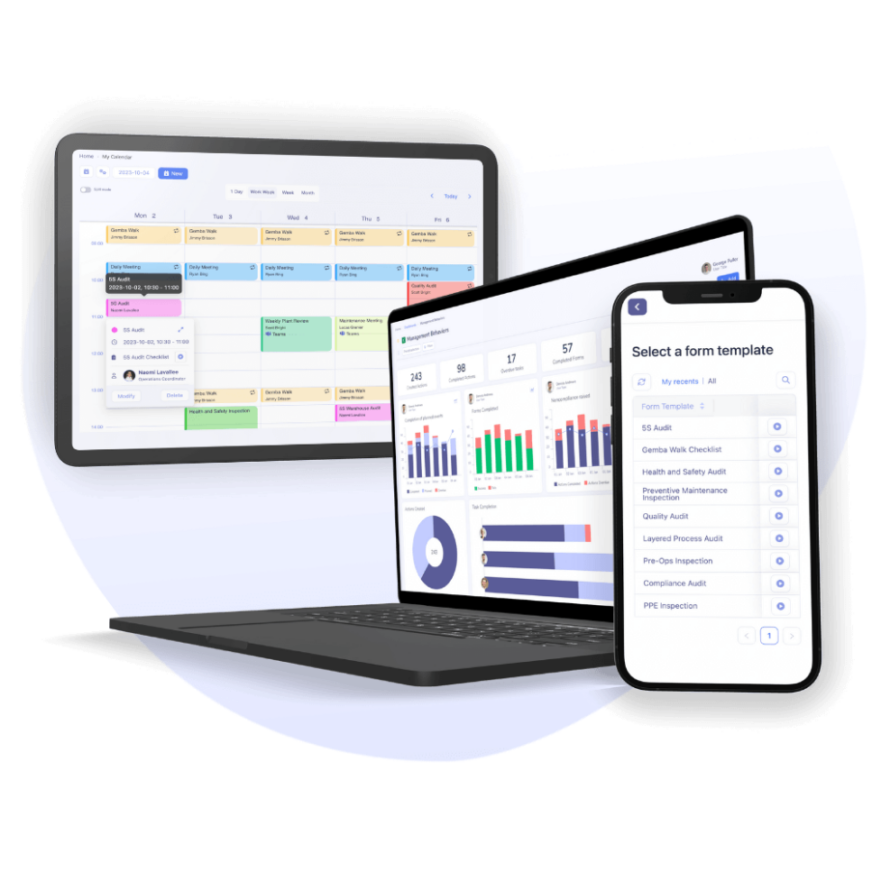Structuring Handover Meetings in Manufacturing

| Audience: | Manufacturing Managers, Healthcare Administrators, Operational Excellence and Lean Management Practitioners, HR Coordinators, Organizational Leaders |
| Last updated: | March 28, 2025 |
| Read time: | 7 min |
- Prevent Silos and Miscommunication: Standardized shift handovers reduce gaps between teams by sharing critical updates, issues, and priorities between day, night, and weekend shifts.
- Structure Meetings and Gemba Walks: Shift handover meetings and gemba walks—both at the end and start of shifts—help supervisors validate operations, identify unresolved issues, and improve real-time decision-making.
- Support Off-Hour Teams: Night and weekend shifts face limited access to resources; a connected management platform like Tervene improves visibility, task follow-ups, and support coordination.
In a manufacturing context with many growing industries, it is frequent for factories to add continuous work shifts in order to keep a production pace that answers the growing demand. However, while necessary, these additional work shifts add a level of complexity to the business’s operations workflow.
More specifically, operations managers must deal with having limited access to support resources, teams working in isolated silos and a lack of visibility over the tasks and responsibilities of the past shifts.
For this reason, implementing standardized shift handovers as a practice is crucial to structure effective communication within the interchanging work shifts while also ensuring a seamless transition of tasks between day, night and weekend shifts.
A formal handover document can facilitate clear communication and understanding among team members during these transitions. Additionally, a project handover checklist can aid in detailing essential items necessary for effective handover, thereby minimizing the risk of oversight during this crucial stage of project management.
What is a Shift Handover?
The shift handover is the moment of transition between two work shifts that succeed each other and where the business’s activities are relayed between employees.
During this moment, supervisors, employees and everyone participating in the shift handover will share helpful information, often documented in a formal handover document, with the employees in charge of the next shift.
This exchange of information, along with the handover materials, will allow employees to understand their workload better while safely starting their shift.
Understanding the Handover Process
The handover process is a critical stage in project management that involves the transfer of completed tasks, responsibilities, and essential information from one team or individual to another. It is a crucial milestone that requires careful planning and execution to ensure a smooth transition and a successful handover of the project.
Shift Handover’s Objectives
The primary objective of a shift handover is to ensure a safe and efficient transition of the business’s activities by keeping everyone on the same page. However, a shift handover can simultaneously serve many other purposes such as:
- Gather and share critical information from past shifts and if needed, escalate it to the appropriate support resources;
- Proactively communicate information and problems that might affect the following shift;
- Review past shifts performance and progression towards objectives and planning;
- Manage and organize the workforce (arriving and leaving);
- Adapt production and operations priorities according to human resources needs and availability.
Key Team Members and Roles
Identifying key team members involved in the handover process is crucial for ensuring a smooth transition. The key team members typically include the project manager, the project team, the client, and the end user. Each of these roles plays a vital part in the handover process, and their collaboration is essential for future collaboration and a successful project handover.
Identifying Key Team Members Involved in the Handover Process
The project manager is responsible for overseeing the handover process and ensuring that all necessary steps are taken to complete the project successfully. They coordinate the efforts of the project team, manage timelines, and ensure that all deliverables meet the required standards.
The project team is responsible for completing the tasks and delivering the project outcomes. They work closely with the project manager to ensure that all aspects of the project are addressed and that any issues are resolved promptly.
The client is responsible for providing input and feedback throughout the project. Their involvement is crucial for ensuring that the project meets their expectations and requirements. The end user is responsible for receiving the final product and providing feedback on its quality.
Their feedback is essential for identifying any areas for improvement and ensuring that the project outcomes meet their needs.
By understanding the handover process and identifying key team members involved, project managers can ensure a smooth transition and successful completion of the project. This, in turn, helps to build trust with clients, increase customer satisfaction, and improve the overall reputation of the organization.
The Importance of Shift Handover Meetings for a Smooth Transition
Since shift handovers are omnipresent in the day-to-day of manufacturers, it is important to create a structure that makes the practice quick and efficient. One way to do this is to have structured shift handover meetings that ensure ongoing support during the transition.
The main objective of a shift handover meeting is to relay the information between teams coming in and teams leaving, ensuring a smooth handover. The meeting focuses on essential information that will help the relaying team adapt, while also reducing the risk of facing issues during the shift.
In brief, this proactive approach helps the people in charge have all the necessary information and lessons learned to efficiently start their shift, while also reducing the quantity of delegated issues.
Ultimately, connecting teams in a management system simplifies shift handovers by breaking silos, accelerating problem resolution and increasing visibility on tasks and follow-ups.Gemba Walks for Easier Shift Handovers
End-of-Shift Gemba Walk
The gemba walk performed at the end of a shift plays a crucial role in the shift handover’s efficiency. In fact, by doing this last floor validation before the shift ends, team members can spot last-minute issues that may have gone unnoticed.
When spotting an issue, the supervisor or the person in charge of the gemba walk can immediately take action to solve the situation before the shift ends, or he can add the issue as a topic of discussion for the upcoming shift handover meeting.
Moreover, the end-of-shift gemba walk empowers the working team to anticipate issues and relevant knowledge transfer to the next group during the shift handover meeting.
Beginning-of-Shift Gemba Walk
Doing a gemba walk at the beginning of a shift allows a first validation of the topics addressed during the shift handover meeting, while also ensuring that no topics or issues went unnoticed. In addition, it helps team members proactively identify risks of upcoming issues for the ongoing shift.
With Tervene, managers and supervisors can immediately transfer the issues raised during a gemba walk into the project plans and order of business of their production or shift handover meeting.
Night and Weekend Shift Challenges for Key Team Members
Most businesses face unique additional challenges when it comes to the night and weekend shifts, making it crucial to ensure a smooth project transition. For the most part, teams working during these uncommon hours usually have more limited access to resources such as maintenance, engineering, IT and other support groups.
Here are some of the challenges of the night and weekend shift teams:
- Lack of visibility on past issues and operations challenges raised by previous shifts
- None or limited access to support groups and resources
- Inefficient transfer and distribution of information between shifts
- Little or no feedback towards raised issues
- Sense of isolation from the rest of the team or not being included as much (little contact between teams, poor visibility on past shifts context, little or no feedback from past situations)
By connecting teams in a management tool such as Tervene, the night and weekend shift managers can assign tasks to support resources or add information to the agenda of certain meetings.
As a result, support groups benefit from an increased amount of information, including contact details on the problems encountered during their absence and night and weekend managers receive the appropriate feedback they need.
Shift Handover Process Best Practices
Some of the best practices for setting up an efficient shift handover structure and a well-executed handover plan have been identified below:
- Setting up shift handover meetings;
- Producing shift handover meeting reports;
- Including a moment during the shift handover to share updates on daily production and quality objectives or any other relevant goals or targets;
- Putting in place both a ”beginning-of-shift gemba walk” (after a shift handover) and ”end-of-shift gemba walk” (before a shift handover);
- Using images, texts and videos to support the information transferred and to simplify problem resolution;
- Giving more precise information about the past shifts activities and issues to the shift manager;
- Avoiding the creation of silos and disconnected teams;
- Supporting shift handovers’ continuous improvement through proper visibility from members on shift handovers efficiency, improvement opportunities and overall feedback;
Simplified Handovers with Tervene
With its connected platform, Tervene equips your management team on their quest to operational excellence by supporting the daily control of operations in a construction project.
Designed for manufacturers, the adaptive platform simplifies daily tasks, standardizes the management and operation control processes, accelerates problem resolution, and improves the communication structure.
Shift Handover – FAQ
Shift handovers ensure continuity in operations by transferring critical information between teams. They reduce miscommunication, avoid oversight, and help align efforts across day, night, and weekend shifts.
A good handover covers key updates, unresolved issues, safety concerns, production targets, and resource availability. It should involve structured documentation or checklists and be supported by visuals when necessary.
Key participants include the outgoing and incoming shift supervisors, frontline workers, and support roles such as maintenance, quality, and engineering—especially when escalations are needed.
End-of-shift gemba walks allow supervisors to spot and resolve last-minute issues. Beginning-of-shift walks help validate transferred information and detect early risks for the upcoming shift.
Limited access to support teams, poor visibility of past issues, and isolation from daytime operations often hinder night/weekend shifts. A connected management platform helps bridge these gaps.


























